With this complete guide for the Cambridge C1 Advanced (CAE) Use of English exam, we’ll see tips and tricks for each part of the exam. The guide will focus on Parts 1-4 of the Reading and Use of English paper belonging to the C1 Advanced exam. Note: Reading and Use of English is technically a Reading task, not a Use of English task, since the exam update in 2015. However, many of us still consider it to be more similar to the Use of English in style and format, which is why it’s included here. If you’d like to know more about which parts of the exam belong with which paper, you can check this handy guide published by Cambridge themselves.
12 USE OF ENGLISH TESTS with answers – C1 Advanced (CAE)
Get all the practice you need with our complete exam book, 12 Use of English Tests, focussed on parts 1-4 of the Cambridge C1 CAE Reading and Use of English paper. Test your skills with 12 CAE Use of English practice tests, then check your answers with the answer key.

Contents
What is the C1 Use of English?
The Cambridge C1 Advanced Reading and Use of English paper is a 1 hour and 30-minute assessment, consisting of 8 parts and 56 questions. These 8 parts are taken together. However, they are split into two separate marks. Parts 1, 5, 6, 7 and 8 make up your Reading mark while Parts 2, 3, and 4 make up your Use of English mark.
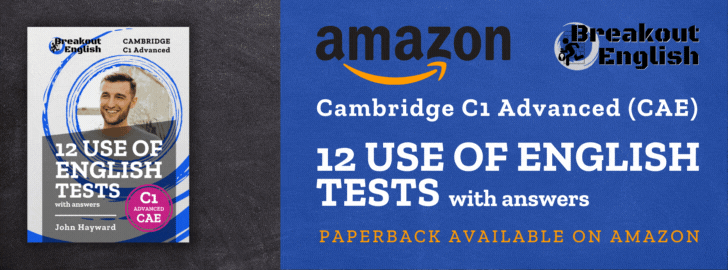
Parts 1, 2, 3 and 4 of CAE Reading and Use of English deserve special attention because they are the most challenging parts for many students. Some people think that Part 1 is a Use of English activity, and it definitely feels like one, but remember that this part is considered a Reading task by Cambridge. Despite this, we’ve included it here because it tests many of the same language points as Parts 2, 3 and 4.
The texts used in the CAE Use of English paper can come from various sources including newspapers, magazines, journals, books (both fiction and non-fiction), and promotional materials.
Part 1: Multiple-Choice Cloze – 8 questions, 1 mark each
This section contains a text with numbered gaps that represent a word or phrase, and 4 possible answers for each gap. The main focus is on vocabulary, including layers of meaning, collocations, idioms, phrasal verbs, and fixed phrases.
Part 2: Open Cloze – 8 questions, 1 mark each
This section contains a text with gaps, each of which represents one missing word. The focus is on grammar and vocabulary, including determiners, modals, pronouns, prepositions, auxiliaries and phrasal verbs.
Part 3: Word Formation – 8 questions, 1 mark each
This section contains a text with 8 gaps, each of which represents a word. You have to change the prompt word to complete the sentence correctly. The focus is on vocabulary, especially affixation.
Part 4: Key Word Transformations – 6 questions, up to 2 marks each
Each question in this section consists of a sentence followed by a key word and a second sentence with a gap in the middle. You have to use the key word to complete the second sentence so that it means the same as the first sentence. The focus is on grammar, vocabulary, and collocation.
When you mark your answers for Part 4, you will notice each answer is split in two. Each half corresponds to one possible point. It is possible to get 2, 1 or 0 points for each question.
How to do CAE Use of English Part 1 – Multiple-Choice Cloze
Timing: 5-8 minutes
Focus: Vocabulary – meaning, collocation, fixed phrases, phrasal verbs, idioms

Part 1 of the Reading and Use of English paper is technically a Reading task, not a Use of English task. However, in the old format of the exam, the Reading and Use of English papers were completed separately and the multiple-choice cloze activity was part of Use of English, hence the confusion. Only Cambridge can tell you why they decided to count these 8 points as a Reading task in the new format of the exam.
Despite this, it’s got the feel of a Use of English task and that’s why it’s included here. The reason it feels like Use of English is that the text has a short length and the focus is on vocabulary rather than comprehension. As you continue learning English, you realise that the language has a wealth of different vocabulary. This is due to its roots in several European languages, all of which provide their influence and their words to make the English language diverse and to make exam tasks like this one especially challenging.
The challenge comes not only with knowing the meaning of the words, but also knowing the way the words are used in context. Sometimes, two words can be completely synonymous, but they are used as parts of collocations, or have different dependent prepositions. Other times, the differences in meaning are subtle and situational, where one word is only appropriate for a specific circumstance.
That’s why it’s important to follow a series of steps when completing the multiple-choice cloze activity.
- Read the title of the task and briefly think about it. What do you already know about this topic?
- Quickly read through the entire text to get a general idea of what it’s about.
- Read up to the first gap in the text and look at what comes before and after the gap.
- Think of words that could fit before looking at the options (this avoids distraction).
- Read the options and eliminate those that are clearly incorrect.
- Compare similar options and consider the following:
- Does the answer collocate with a word in the text?
- Does the answer use a specific dependent preposition before or after it?
- Does the answer form part of a fixed expression or idiom?
- Is there a clue in the grammar of the sentence (e.g. infinitive or -ing)?
- Is there a clue in the punctuation of the sentence?
- After choosing your answer, read the sentence again and see if it sounds correct.
That all sounds fine, but what about all those really confusing words or the ones you just don’t know? There may be questions that you can’t answer in the exam, but don’t worry. There are lots of other points available in the exam and one or two incorrect answers here won’t hurt you. Move on to the next part and come back later. If you really don’t know at the end of your time, guess. You don’t lose points for incorrect answers, so never leave a multiple-choice question blank.
How to do CAE Use of English Part 2 – Open Cloze
Timing: 5-8 minutes
Focus: Grammar and vocabulary – pronouns, determiners, articles, prepositions, etc.

The big difference in CAE Use of English Part 2 is that you don’t have any options. The text is about the same length as Part 1, but in this case, words have been removed and you have to use your knowledge of English to fill the gaps without any extra help.
What does this mean in practice? In any sentence in English (or any language), there are content words and function words. Content words are the most important part of a sentence. They tell us essential information and often answer who, what, how, why and where questions. The function words, however, do not contain any information. They serve to keep the sentence together and provide a structure for the content words. Take a look at the following example sentence:

If you remove all the function words from this sentence, you can still understand its meaning.

But if you remove the content words, you are left with nonsense.

In the open cloze task, you are tested on your ability to use function words. This means you need to understand the way the language is glued together and how the intricacies of the language work. This is more difficult than it sounds because function words don’t tend to be the part of language that our brains focus on. In fact, we usually skip over them as quickly as possible to get to the content faster.
Try to follow a systematic and analytical approach when completing this part of the exam. You’ll notice the first steps are the same for all parts of the exam.
- Read the title of the task and briefly think about it. What do you already know about this topic?
- Quickly read through the entire text to get a general idea of what it’s about.
- Read up to the first gap in the text and look at what comes before and after the gap.
- Analyse the gap and decide what type of word is missing. Is it an article, a preposition, part of a phrasal verb, part of a linking word?
- After you decide the category, choose the word that feels best to you.
- Remember that contractions (e.g. don’t, I’ll) count as two words, so they are not possible.
- Reread the complete sentence with your answer included. Does it make sense?
Like in Part 1, you may be stuck on a word. Choose any answer and move on. If you know it’s a preposition, just choose in, or a relative pronoun, which. You may get lucky. Try not to leave an empty gap, but, if you have no idea, don’t risk points in other parts of the exam by wasting time.
How to do CAE Use of English Part 3 – Word formation
Timing: 5-8 minutes
Focus: Vocabulary – word classes, affixation

The word formation task, CAE Use of English Part 3, is your time to shine. This is by far the part of Use of English which is easiest to prepare and study for ahead of time. The way to do this is to focus on word families and the prefixes and suffixes that form different word classes. These can be studied in sets of commonly appearing nouns, adjectives, verbs and adverbs. And don’t forget about forming negatives.
Other than studying lists, pouring over flashcards and learning affixes, what can you do to improve the word formation task? More than any other task, this is where reading will make a difference. Read in English every day. Make a plan to read a book, read newspapers, read online magazines, read scientific papers, read anything and everything that you can because this will improve your vocabulary more than any other practice you can do. If you think you don’t have time to read in English, make time. If you can’t, then you probably don’t have time to prepare for a C1 level exam either.
As you complete the word formation task, you can follow similar steps to other parts of the exam.
- Read the title of the task and briefly think about it. What do you already know about this topic?
- Quickly read through the entire text to get a general idea of what it’s about.
- Read up to the first gap in the text and look at what comes before and after the gap.
- Analyse the gap and decide what type of word is missing. Do you need an adjective, noun, verb, adverb, negative?
- Once you know the word type, consider the affixes you can use. Different affixes are only used for certain word classes.
- Consider if more than one change from the root word is necessary. Sometimes you may need to go from verb > adjective > adverb > negative adverb all in one question.
- Double and triple check you haven’t made any simple mistakes.
- Is the spelling correct? Check your double letters!
- Do you need a plural noun? Sometimes you have to read the full sentence to determine this.
- Is it an adjective or an adverb? Sometimes the difference isn’t obvious, but adjectives describe nouns while adverbs describe actions.
- Do you need a negative word? Check the meaning of the sentence and check that you have made the word negative if necessary.
- Reread the complete sentence with your answer included. Does it make sense?
Unlike some other parts of the exam, you should aim to get close to 100% on the word formation task. This is the task that can help to reduce the damage caused by an especially difficult Use of English Part 2 and/or Part 4. So don’t forget to study and read until you feel comfortable with a wide range of words.
Get some extra practice with challenging prefixes (up, down, over under) and negative prefixes with these free downloadable materials.
How to do CAE Use of English Part 4 – Key Word Transformations
Timing: 10-15 minutes
Focus: Grammar and vocabulary – all aspects

Key word transformations are the part of the exam that everyone loves to hate. CAE Use of English Part 4 is no joke and will require extensive preparation. It is also worth more than any other part of the exam. There are only 28 points available in the Use of English paper, and 12 of these come from key word transformations because each question has two possible points. This means that each key word transformation question is worth over 7% of your Use of English mark. The entire task is worth about 43% of the total.
There is a process to completing key word transformations effectively. This process can help to complete the task a bit faster and avoid simple mistakes.
- Read the first sentence carefully and make sure you understand it.
- Read the second gapped sentence and underline any information in both sentences which is repeated. This helps to identify the section of the first sentence that needs transforming.
- Read the key word and think about what language the question is testing. Is it conditionals, reported speech, passive, phrasal verbs, fixed expressions?
- Complete the second sentence, being careful to include and not to change the key word.
- Check that you have included all the necessary function words.
- Does the sentence need an article?
- Does it need a preposition?
- Does it need a pronoun or a name used in the first sentence?
- Check the grammar.
- Do you have the correct verb tenses? Generally, they should be the same as in the first sentence. For example, don’t switch from present perfect to past simple unless the question is designed for you to do so.
- Do you have the correct verb patterns? Remember your rules for when a verb needs to be in infinitive or -ing form.
- Do you need any plural nouns?
- Check the spelling. You will lose points in Use of English for incorrect spelling.
- Count your words and make sure it is between three and six. Contractions count as two words for key word transformations.
- Reread both sentences and check that everything makes sense.
Each half of a key word transformation answer is worth a point, so even if you don’t know the full answer, you should always complete as much as possible. You may still get one of the two possible points. Likewise, always double check you haven’t forgotten a word. It can be easy to miss a preposition or article, but it can also be easy to miss a component of the first sentence that you have to include in the second. For example, if the first sentence includes an adverb of frequency, then that idea has to be included in the second sentence as well. Maybe your answer is grammatically correct without it, but it won’t get both points unless this element is included.
Check out our detailed guide for how to do CAE Use of English Part 4 key word transformations.
Breakout English also offers 230 KEY WORD TRANSFORMATIONS as a digital download.
Get 12 Use of English Tests
Looking to pass the Cambridge C1 Advanced (CAE) Use of English test? Look no further than this comprehensive exam practice book, containing 12 Use of English tests covering parts 1-4 of the exam.
With a wide variety of tasks, including multiple-choice cloze, open cloze, word formation and key word transformations, this book has everything you need to prepare for every type of question you may encounter in the exam.
Whether you’re a student looking to improve your chances in the exam or a teacher training learners for their big day, this book is an essential resource for anyone preparing for the Cambridge C1 Advanced (CAE) Use of English test.
The digital copy includes the CAE Use of English pdf with all the same content as the paperback copy, which is available on Amazon.
These materials have been designed to represent the same quality and standards as authentic exam materials.
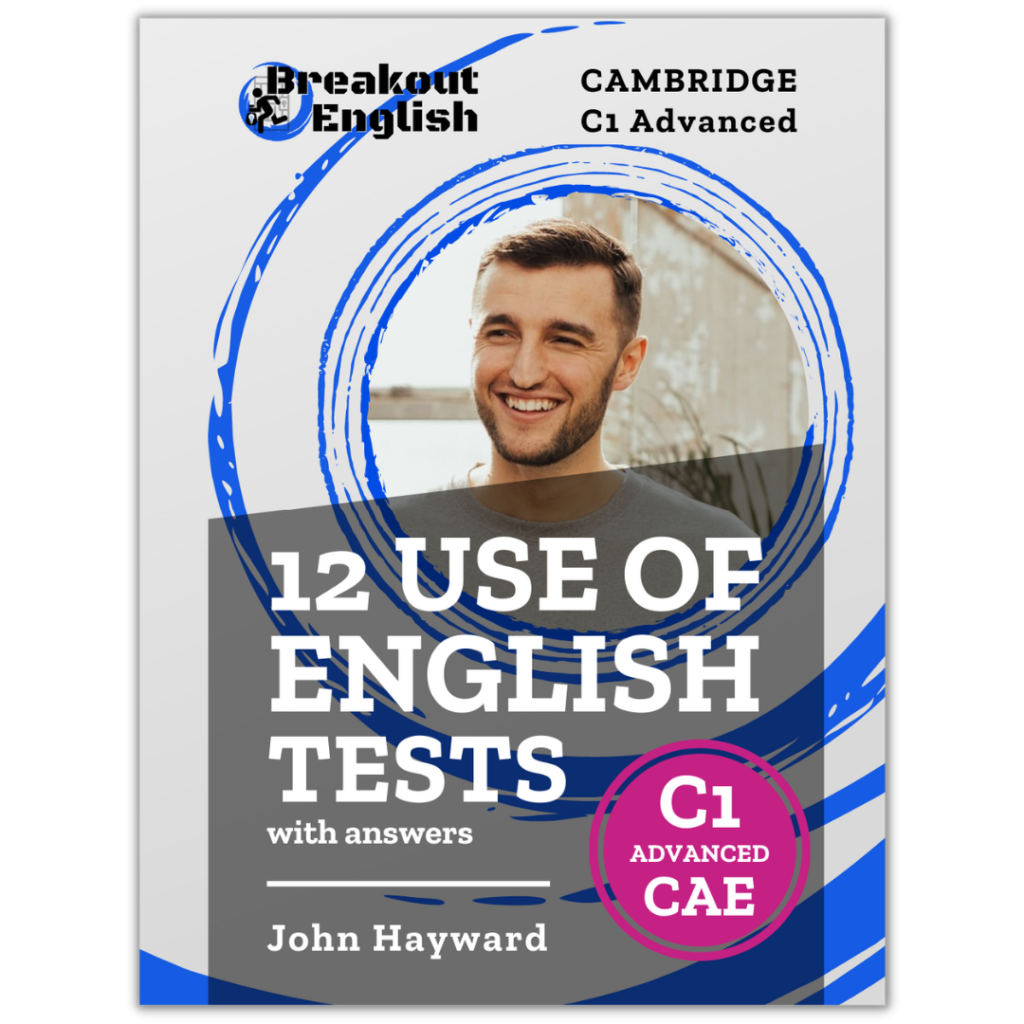
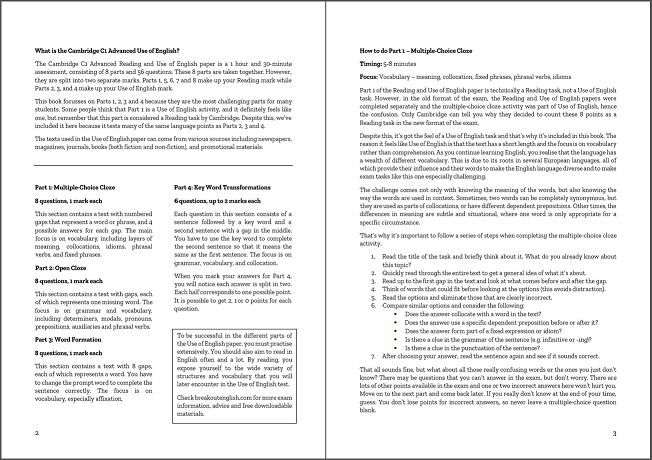
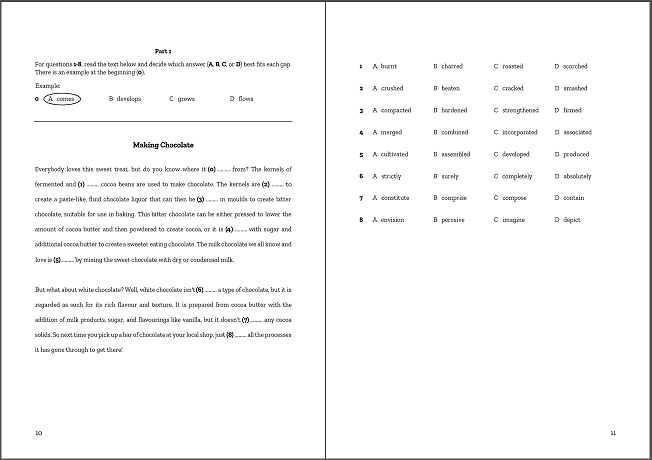
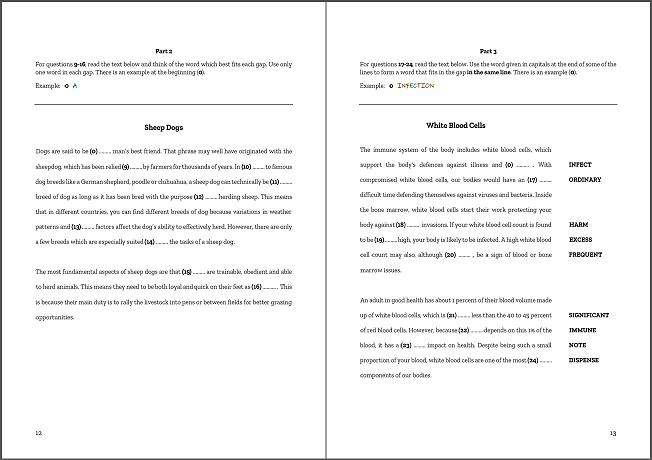
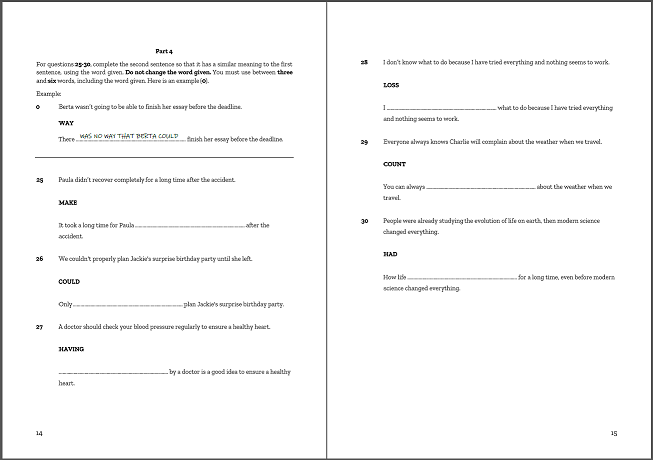
Proceeds from paid materials go towards helping Breakout English continue to offer the majority of our quality materials 100% free and accessible to teachers and learners of English. Thank you for your support!

